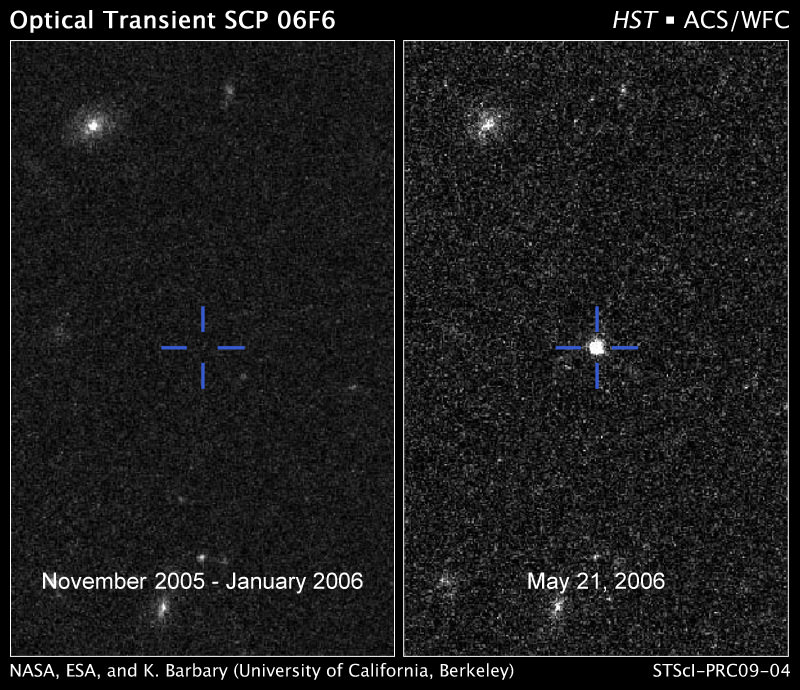[/caption]
The Hubble Space Telescope serendipitously captured a mysterious burst of light on February 21, 2006. Over the next 100 days, the object, cataloged as SCP 06F6, brightened and then slowly faded. Astronomers do not know the object’s distance, so it can either be in our Milky Way galaxy or at a great astronomical distance, and the light-signature of this event does not match the behavior of a supernova or any previously observed astronomical transient phenomenon in the universe. It might represent an entirely new class of stellar phenomena that has previously gone undetected in the universe, said Kyle Barbary of the Lawrence Berkeley National Laboratory (LBNL) in Berkeley, Calif.y researchers. “No one has been able to come up with a good explanation for this object” he said at a press conference at today’s American Astronomical Society meeting in Long Beach, California. (Read on for an outlandish explanation one scientist proposed!)
Astronomers commonly observe intense flashes of light from a variety of stellar explosions and outbursts, such as novae and supernovae. But the rise and fall in brightness has a signature that simply has never been recorded for any other type of celestial event. Supernovae peak after no more than 70 days, and gravitational lensing events are much shorter. Therefore, this observation defies a simple explanation, said Barbary. “We have never seen anything like it.”
Hubble was aimed at a cluster of galaxies 8 billion light-years away in the spring constellation Bootes. But the mystery object could be anywhere in between, even in the halo of our own Milky Way galaxy.
Papers published by other researchers since the event was reported in June 2006, have suggested a bizarre zoo of possibilities: the core collapse and explosion of a carbon rich star, a collision between a white dwarf and an asteroid, or the collision of a white dwarf with a black hole. At the press conference Barbary was asked what the most bizarre explanation of the object was: “Jokingly, someone said it was another civilization turning on their Large Hadron Collider and exploding,” — which got laughs from the audience. “Don’t quote me on that!,” he added.
But Barbary does not believe that any model offered so far fully explains the observations. “I don’t think we really know what the discovery means until we can observe similar objects in the future.”
All-sky surveys for variable phenomena, such as those to be conducted with the planned Large Synoptic Survey Telescope, may ultimately find similar transient events in the universe.
Source: HubbleSite


Finally …
Aliens!
o, no, where Occam’s razor ?
Hans
…100 days?
…what if 2000 years ago, one just like it wrote history
Damn I love these serendipitous discoveries of transients. I am literally foaming at the mouth for LSST to come online – in my opinion it is akin to bringing a video camera to the heavens when all we have currently is an old SLR (yes – I just referred to our finest telescopes as ‘old SLRs’. Ballsy.).
Clearly many new classes of transient event will be discovered with it, when we are ‘rolling tape’ almost all of the time.
A phenomenon.
Two phenomena.
Thanks Sili, I’m being buried under press releases and my mind is not at tip top form!
Maybe we just saw another Big Bang a long long way off. It would hopefully stop the arrogant theory of there having been nothing before ours, and the realisation that maybe the universe has always been here and goes forever and our big bang was just a local incident. Now that’s exciting
clear skies
Stephen
Stephen — If you’re right, that might account for the apparent asymmetry between one “side” of the observable and the user, as picked up in CMB observations by WMAP et al., as well as “dark flow” and the fact that we and a tremendous number of other galaxies all seem to be moving in the direction of the Great Attractor, whatever it may be. The Great Attractor may instead by the Great Repulsor,180 degrees across the sky from the point we all seem to be heading for, the result of a Little Bang.
Light emitted from the distruction of Alderaan?
We have witnessed an alien civilization being annihilated because they were sending out signals looking for E.T.
We’re next.
Maybe it was just Bootes shaking. Astronomers need to look down once in a while to be able to recognize these, when they occur.
It’s quite obviously nukes exploding from Battlestar Galactica (2003) doing battle with an evil race of incredibly hot robot cylon women. Science needs no further explanation .
.
Quoting the Hubble site: “The spectral fingerprints of light coming from the object, cataloged as SCP 06F6, also have eluded identification as being due to any specific element.”
So it must be the light from planet Krypton’s explosion
Lol…liking the joke of the LHC, I simply think it was someones fingerprint on the lense…or somone left the polish on the lense….either that or “God” farted and lit it….
I assume that this event recorded in 2006 has not repeated itself and it is probably too soon to determine if it is repetitious or a one time event.
That’s easy: it’s the ramscoop drive of the Nuwen arriving at our solar system in search for the device to stop the blight.
I really enjoyed the replies, a lot of ‘cool’ people out there!
What is so mysterious about this outburst is we don’t know when it happened, was it recent or at the start of the universe? Its cool that the universe can never stop being full of surprises!
Why can’t it be red-shifted to determine distance?